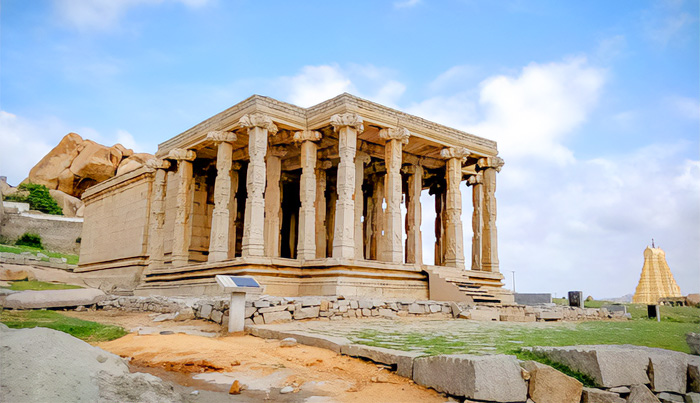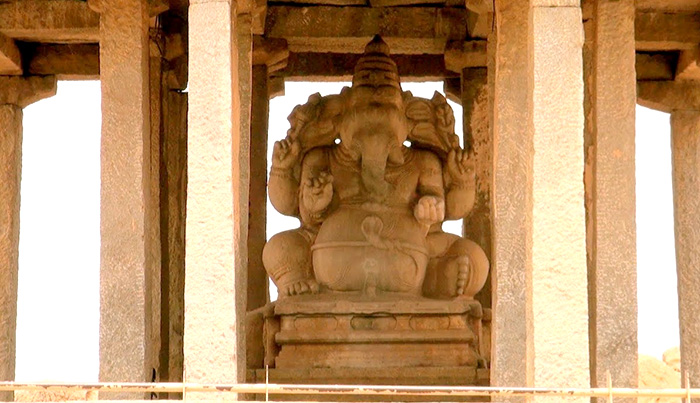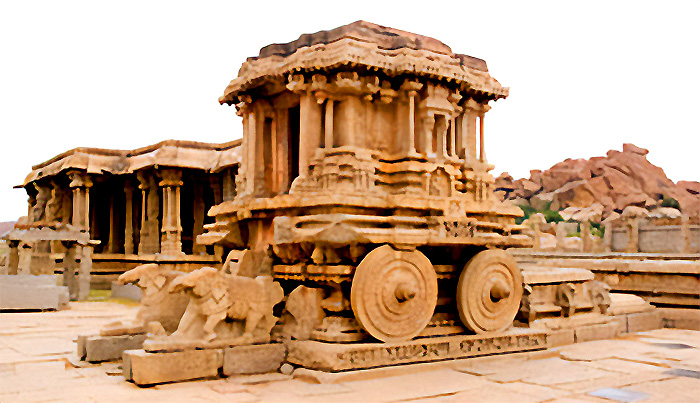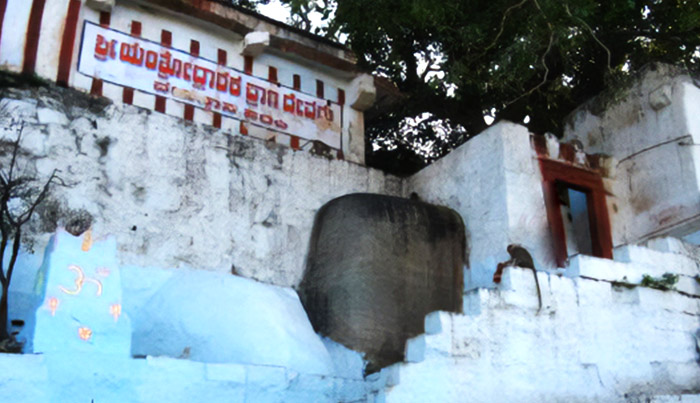Hampi
Hampi is a village in northern Karnataka and the name is derived from Pampa, which is the old name of the Tungabhadra River on whose banks the city is built. Hampi is located within the ruins of Vijayanagara, the former capital of the Vijayanagara empire. Possibly predating the city of Vijayanagara, this village continues to be an important religious centre, housing the Virupaksha Temple. The village of Hampi contains several other monuments belonging to the old city. It extends into some of the old ceremonial streets of Vijayanagara. As the village is at the original centre of Vijayanagara, it is sometimes confused with this ruined city. The Vijayanagara ruins are listed as the Group of Monuments at Hampi as a UNESCO World Heritage Site. Distance from Hampi to Mantralayam is 159.5 km and travel time is around 3 h 12 min.
The name "Hampi" is an anglicized version of the Kannada Hampe (derived from Pampa). Over the years, it has also been referred to as Vijayanagara and Virupakshapura (from Virupaksha, the patron deity of the Vijayanagara rulers).
Hampi is identified with the historical Kishkindha, the Vanara (monkey) kingdom which finds mention in the Ramayana. The first historical settlements in Hampi date back to 1 CE. Hampi formed one of the cores of the capital of the Vijayanagara empire from 1336 to 1565. It was destroyed by Muslim sultans. Hampi was chosen because of its strategic location, bounded by the torrential Tungabhadra river on one side and surrounded by defensible hills on the other three sides.
The site is of great importance in terms of architecture and historical significance. The demography is abundant with large stones which have been utilized to make larger than life statues of god.
One can see a structure of historic importance every quarter of a mile.
Sadly the city is in ruins due to invading Islamic aggressions who treat Idol worship as blasphemy. Many statues have been destroyed or damaged and successive governments have not been able to keep the place free from treasure seekers who cause further damage.
Recently the Archaeological Survey of India has been conducting continuous excavations in the area to discover more artifacts and temples.
Hampi has various notable Hindu temples, some of which are still active places of worship. Virupaksha Temple complex Also known as the Pampapathi temple, it is a Shiva temple situated in the Hampi Bazaar. It predates the founding of the Vijayanagar empire. The temple has a 160-foot (49 m) high tower at its entrance. Apart from Shiva, the temple complex also contains shrines of the Hindu goddesses Bhuvaneshwari and Pampa.
1000 Shiva Lingas in Hampi
Ganagitti Temple, Hampi
UNESCO World Heritage Sites
Hemakuta Hill Shiva Temple
Sasivekalu and Kadalekalu Ganesha
Sasivekalu and Kadalekalu ganesha are two huge stone images of Ganesha on the slope of the Hemakutam hill. The Sasivekalu Ganesha is about 2.4 metres high and ironically named after the mustard seed. The god is seated in a large and open mandapa, with plain rough square pillars. The right hand holds the ankusa and broken tusk, while the upper left hand holds a looped pasa. The lower left hand and the trunk are broken. The other monolith in the same vein, is the Kadalekalu or the groundnut Ganesha.The huge seated god, carved in the round out of a massive bo.


Virupaksha Temple, Hampi
The Virupaksha Temple has been considered throughout centuries, to be the most sacred of the temples at Hampi. The main shrine is of Lord Shiva and is in the form of a linga. The name Pampapathi is from the fact that he married Lord Brahmas daughter Pampadevi. The temple is situated in the picturesque surroundings on the southern bank of river Tungabhadra near Hemakuta Hill. The 52-meter high main gopura or the tower has nine storeys and faces the Virupaksha bazaar, the first two storeys are in stone and the rest in brick and morter.The second gopura with three storeys in the inner sanctum.The second gopura with three storeys in the inner sanctum was built by Krishnadevaraya, the most powerful ruler of the Vijayanagara Kingdom, during which the dynasty was at its golden peak, with its vastness increasing from Cylone to Orissa. The Rangamantapa was also built during his period; it has 5 aisles and 16 composite pillars to support the structure. Till date one can see the stucco work and paintings depicting scenes from Ramayana and Mahabharata. Another interesting feature of this temple is the water from Tungabhadra River, which flows in a narrow channel along the terrace of the temple, then desends to the temple kitchen and finally flows through the outer court, back to the main stream. The bazaar facing the main gopura is called virupaksha bazaar where once upon a time, priceless Rubies, emeralds, diamonds and precious stones were sold in weighing scales,it consists of a wide and long road with two storeyed stone built consists of a wide and long road with two storeyed stone buildings on either side. To the north of the Virupaksha temple, one can see about 20 shrines, which are probably among the earliest temples at Hampi. Which have a mix of South Indian and Chalukyan features, you can also see many Jaina temples around this site.
Lakshmi Narasimha, Hampi
The image of Lakshmi Narasimha, better known as Ugra Narasimha, is hewn out of a single monolith. Which has been very badly mutilated. It shows Narasimha seated with Lakshmi on his left lap. At present, except the right hand that embraces his back , the whole figure of Lakshmi the thighs and legs of Narasimha are mutilated. The sculpture was damaged during the attack of the capital by the victorious Bahamani sultans in 1565 A.D. The Narasimha statue with an articulately chiselled crown and large eyes still retains his awasome charm. Above him rises the stately Adisesha, the seven headed snake serving him as a canopy. On top of the head is a carved lion's mask. The entire image of Narasimha is set within a makara-torana. This image is about 6.7 metres in height. It was carved out in 1528 during the rule of Krishnadevaraya. Though the image is enclosed by walls and a passage, the roof if at all contemplated, was obviously never completed. Only a few metres to the left of the nrasimha image, is the Shiva linga, cut out of a huge boulder and is popularly known as Badavi-linga. It is completely intact and measures about 3 metres in height. It is enclosed by walls and a roof. The base of the linga is perenially under water.
Hazara Rama Temple
The Hazara Rama Temple is a veritable picture gallery with its walls and pillars representing a highly artistic and magnificent attempt to capture in stone the immortal legends of Ramayana. The most prominent, among the reliefs of Ramayana in the temple are those of the Rishyasaringa performing the putra-kamashthi yaga, Sita's svayamwara, and Rama shooting an arrow through seven trees. On the columns of the sanctorum are two small reliefs of Vishnut attempt to capture in stone the immortal legends of Ramayana. The most prominent, among the reliefs of Ramayana in the temple are those of the Rishyasaringa performing the putra-kamashthi yaga, Sita's svayamwara, and Rama shooting an arrow through seven trees. On the columns of the sanctorum are two small reliefs of Vishnu. On the columns of the sanctorum are two small reliefs of Vishnu in the form of Rama Avatara. The exteriors of the north, east and west walls depict five friezes, showing elephants, horses, infantry, dancing girls and scenes from shri Krishnaleela.The Hazara Rama temple, which was probably begun by one of the ealry Vijayanagara rulers, represents many interesting transitional features. The main entrance-porches with their early architectural features. The main entrance-porches with their early architectural features, the presence of early type of pillars in other parts of the temple, and the absence of gopuras tell us that the temple dates from an earlier period. The inner courtyard has finely polished pillars over which the roof is supported. The ornate Amman shrine with its bas-reliefs of a royal personage was perhaps an addition made in the time of Krishnadeva Raya. The name of the Hazara-Rama temple is populaly taken to mean the temple of the thousand Rama's on account of the numerous Ramayana bas-reliefs on its walls. But the temple was evidently called Hajara-Rama, because it was the palace-temple and was also at the entrance to the royal palace-enclosure. One can also see a long monolithic stone turf outside the temple, which was probably used to feed the horses of the people visiting the durbar.

Dasara-dibba or Mahanavami-dibba
The massive stone basement called the Dasara-dibba or Mahanavami-dibba, played a prominent role during the celebrations of the nine-day Navaratri festival. Paes states that it was erected after Krishnadeva Raya's victorious campaign in Orissa. The monument is also known as the Throne-platform or, as Paes called it, the House of Victory. Originally this platform must have been gorgeously painted and decorated, having pillared hall of several storeys. Contemporary records refer to the beautiful super structures on the Mahanavami-dibba and the other platforms, but of these there is no trace now existing. The remains consist of a massive square granite-faced base in three diminishing tiers, the lowest being 40 metre square and the topmost 24 meter square. The structure faces West. The walls of the tiers are covered with rows of boldly-carved horizontal friezes of horses, elephants, warriors, dancers,musicians. A group of people with plaited hair and conical eyes represent members of Chinese Embassy. Another interesting relic near the north face of dibba is a huge monolitic stone door, which imitates the wooden original including bolt and socket. In front of the mahanavami dibba One can see large and ornate granite base generally believed to represent the remains of royal palace. Also seen square chamber below ground level, which must have been a place to conduct secret meetings.
Yeduru Basavanna Temple
The 500 year old sculpture of monolithic bull Nandi, in Hampi, is locally called the Yeduru Basavanna or Nandi. The temple is located in the Virupaksha Bazaar, Hampi. The statue is placed on a two storied pavilion built on an elevated platform.

This structure is partially damaged or destroyed. It has withstood the extensive destruction initiated by the Mughal attackers that led to the downfall of the Vijayanagara kingdom in 1565 A.D.
Nandi or monolithic bull is said to be the mount of Lord Shiva and it is symbolic because it faces the Lord Shiva shrine, Virupaksha Temple located opposite end of the street, about a kilometer from it. A little distance from the Nandi, one can spot a tall stone lamp post with metal spikes over it. According to Hindu mythology Nandi was born as a result of sheer devotion and penance shown by sage Shilada, towards Lord Indra. The sage wanted an immortal child, and only Lord Shiva could grant that wish. So as advised by Lord Indra, Shilada started his worship. The worship continued for centuries, but Shilada didn't moved an inch. His condition worsened to such an extent that termites began eating up his body. Seeing this, Lord Shiva appeared, and out of his bones created Nandi, the immortal child. The Lord also restored Shilada. The epic says that it was Nandi who cursed the demon Ravana that his kingdom will be burnt to ashes by the Vanara or monkey clan.
In between the monolithic bull and Virupaksha temple, is the Hampi Bazaar which has been there since the Vijayanagara Empire. The steps beside the monolithic bull takes visitors to the Achyutaraya Temple which is on the other side of the hill. One can also go to the Vittala temple after reaching here. Another way towards the right from Nandi leads to the Matanga Hill. The boulders behind the Nandi gives a scenic beauty and is a real treat for tourists in Hampi.
Vittala Temple
The vittala temple is the most magnificent of the religious edifices at Hampi. The Vittala temple stands on the southern bank of the Tungabhadra and may be reached from the west by walking on from Hampi bazaar along the riverbank, or from the east through the Talvaragatta Gateway. The Vittala temple potrays the high watermark of perfection of the Vijayanagara style and one may well say that there is no other building which could stand in comparison with its florid magnificence. The temple stands in a large rectangular enclosure (164m x 94.5m). The three lofty Vijayanagara gopuras on the east, north and south are now dilapidated. The main temple was dedicated to Vishnu in the form of Vittala. The mandapa contains 56 pillars, each 3.6 meters high, 40 of which are regularly disposed to form an aisle. While the remaining sixteen form a rectangular court in the center. Each pillar is a massive composite sculptural unit measuring as much as 1.5 meters across and are a group of monolithic sculptures. The Vittala Temple was the most ornate and proportionate temple of its time. The interesting part of the pillars, which have musical motifs, is the kind and quality of sound one can hear when struck. These pillars are of different size, shape, length and width, which makes them give sounds of different musical instruments. One might note that these are monolith sculptures. This temple is a living example of the scientific development during the Vijayanagra period. It is said that during that time the temple exteriors were probably covered with thin muslin cloth from the hooks as seen, to make the sound echo in the central courtyard where the dances were performed. It is also said that one could hear the musical pillars from a distance of 1.5 kms. The temple is now in a damaged condition due to the attack of Bahamani invaders in 15 th century, who burnt the temple due to which the clarity of sound has drastically come down.Another important monument in the temple complex is the Stone Chariot, dedicated to Lord Garuda, the vehicle of Lord Vishnu. Till date one can clearly see the paintings done during that time. The best part is that the stone wheels in the chariot still rotate. The other mandapas in this complex are Kalyana mandapa and 100-pillard hall, which are also worth seeing.

Balkrishna Temple, Hampi
The Krishna Temple in Hampi commemorates the victory of King Krishnadevaraya, the most renowned and powerful king to have ruled Vijayanagara. It is situated on the Hampi main road in Karnataka.

Lord Krishna is one of the prime deities to the followers of Hinduism. Of all his forms, the infant Krishna or more popularly known as Balkrishna is the commonest. The Krishna Temple in Hampi was built in the honor of Balkrishna or Bal Gopal.

The reign of Krishnadevaraya saw many religious and cultural developments in the form of temples. The Krishna Temple in Hampi was built by King Krishnadevaraya after his victory in Odisha. King Krishnadevaraya cherished his successful conquest of Udaygiri by erecting this beautiful piece of architecture. The temple was built in 1513 CE, and was completed over a period of four years.
While returning from his stupendous victory at Utkala or Udaygiri, King Krishnadevaraya brought from there a huge carved idol of Lord Krishna. This idol, he installed in the newly built Krishna Temple. The Balkrishna idol became the representation of his victory.
Yantrodharaka Hanuman Temple, Hampi
Yantrodharaka Hanuman Temple gets its name from the image of Hanuman placed inside an amulet. The position of Hanuman is different from any other image of Lord Hanuman that can be found in Hampi. This temple is the second most important shrine dedicated to Lord Hanuman in Hampi.

According to some legends, this temple is built on the place where Hanuman and Lord Ram met for the first time. Others believe that Sri Vyasaraja used to pray to Lord Hanuman in this place by drawing an image of Lord Hanuman on the rocks. By the time he finished his prayers, the picture would have disappeared. When this happened for 12 days in a row, he pleaded with Lord Hanuman to appear before him. When the Lord appeared, he asked Sri Vyasaraja to constrain him in a six-sided amulet and build a temple in the area.

The Anjaneya Temple is located on a hill on the banks of the Tungabhadra River. The inner sanctum contains an image of Lord Hanuman enclosed within a hexagonal amulet. Hanuman has been pictured in a meditative state. This is a marked deviation from other depictions of Lord Hanuman. In Hampi, most depictions of Lord Hanuman show him standing with one hand raised and the other on his hip. It is only in this temple that Hanuman appears in a prayer position. In this image, Lord Hanuman’s crown has been formed by his tail. 12 monkeys have been carved around this amulet. They represent the 12 days Sri Vyasaraja prayed to Lord Hanuman. Each monkey holds the tail of the monkey in front of him but is facing backward. Seed syllables have also been carved around the amulet.
Lotus Mahal, Hampi
The structure is a fine representation of Hindu Sikharas, which are the horizontal pyramidal-stepped variety with neatly workd out stupis on top. It is probable that music concerts were held on the lower floor for the benefit of the womenfolk of the royal family. To the south east of Lotus Mahal one can see an octagonal watch tower which has arched openings in 2 layers, the lower half of these openings are covered with walls, which is evident that the woman folk used this tower to have a glimpse of the activity beyond the zenana enclosure.

Elephant Stable
The elephant's stable is an oblong building, and is located outside the Zenana Enclosure, it is a structure of considerable size. If any building has greater Islamic character about it, it is the Elephant Stables. Facing west, it consists of a row of eleven rooms, each room with a huge dome for its roof. The central portion of the building has stairways, which lead to the upper pavilion that retains Hindu elements of Architecture, though the super-structure, which was in the form of a sikhara, is now in ruins. The most interesting aspect of the structure is its domes. These huge domes are of different types - drum - shaped, ribbed and stepped-pyramidal shaped. The rooms have lofty entrances in the form of arches and in between two rooms, the exterior has false arched windows. The rooms are so spacious that it was possible to tie four to five elephants in each room. The Elephants were apparently chained to the iron hooks, which still remain embedded in the decorative ceiling. To the south of Elephants stable is the Guards barrack, which is another example of Indo-Sarasanic architecture. It is also oblong in plan, the facade is made up of a series of eleven arched openings, of which the central arch houses the entrance to the building.
Stepped Tank
The recently excavated stepped tank made out of black schist, is very ornate and it is one of the most beautiful monuments. This small but neat tank measuring about 22 meters in square, and 7 meters deep, has 5 distinct tiers of steps fitted in pleasing pattern. This tank is very proportionate in terms of design. The mason marks on each step shows the exact position and direction in which it had to be placed, this only reveals that the whole stepped tank was pre-fabricated elsewhere and later assembled in the palace area. The water to this tank was drawn through the intelligently designed stone aquaduct which is well preserved till date. The massive stone basement called the Dasara-dibba or Mahan.
Queen's Bath
One of the best-known structure at Hampi is the Queen's Bath. Built in the Indo-Sarasanic style, it is severely plain on the exteriors. It is a square building consisting of square bath, which is surrounded on all sides by an arched pillar. The areas of the cloister are pleasing in design and contain some fine stucco work. The ceilings are of different types, ranging from square to round to paramedical in design. More interesting are the arched balconies, which project over the bath. The fresh water to the bath was supplied through a channel. The bed of the bath is provided with holes to drain the water. This was probably used by the women folk as a recreation spot.
Hampi Utsav
The Hampi utsav is a recreation of the grandeur of that era, of the glory that was Hampi. The Dussehra festivities of the Vijayanagar kings were celebrations of great religious fervour and were held with incredible pomp and show. Today, it is that same ecstatic outpouring feeling that magically revives a bygone splendor and brings alive the ancient city. Dance, drama, music, fireworks, puppet shows an unforgettable Varity of folk artistes and their traditional skills are on display. Shops do brisk business with rural artifacts. Colour, gaiety and excitement follow the long and spectacular processions which wind their way to the sounds of pipes and trumpets.These Utsav are beingheld on 3 / 4 / 5 th of November every year. All the important monuments are illuminated during important days.
Bird Watching at Hampi
Hampi now has another attraction besides its architectural grandeur - Greater Flamingos that have arrived from the Rann of Kutch. More than 3,000 flamingos have arrived in April 2014 at the backwaters of the Tungabhadra dam, 16 km from Hampi, on their way back home.
With their long necks, delicate pink legs, cup-like beaks and white bodies, the flamingos can be seen gracefully wading through the shallow waters of the Tungabhadra. These winged beauties are spotted in the vast mud banks of the reservoir in early winter and from March to early June every year.
Antique Shopping and Souvenirs of Hampi
The Hampi Bazaar also known as the Virupaksha Bazaar is a unique attraction of Hampi. Located in front of the Virupaksha Temple, the Hampi Bazaar is a well-known market place that spreads for more than one kilometer. The road passing through the market has series of old pavilions on both sides. The place used to be a thriving market during the days of the Vijayanagara Empire. Though the market has lost much of its sheen and significance, it is still popular among the tourists.
The Hampi Bazaar was once the centre of flourishing trade. It was a well-planned market area and the series of pavilions had an organized structure. Some of the pavilions were two stories. It also had the residences of many rich and important people of that era. It was a market that catered to the demands of the rich people as well as the general masses. Today what remains at Hampi Bazaar is just a shadow of its glorious past.
Hotels, Boarding, Lodging & Accomodation in Hampi
Centre declares Hampi as Best Tourism Village
Wednesday
11-Oct-2023On Wednesday 11 October 2023, the Ministry of Tourism bestowed the title of "Best Tourism Village of India-2023" upon Karnataka's renowned destination. This recognition not only honors the state but also paves the way for increased funding to enhance rural infrastructure and promote its cultural heritage. The announcement coincided with the celebrations of World Tourism Day. The UNESCO-protected site participated in the Best Tourism Village Competition-2023 edition, organized by the Central Nodal Agency for Rural Tourism and Rural Homestays under the Ministry.